This is our review of the best Wi-Fi extenders with Ethernet ports in 2024.
We bought a dozen Wi-Fi extenders to test and determine which ones are the best.
After testing and comparing all the extenders with Ethernet, we determined that the Netgear X6S EX8000 AC3000 is our top recommendation. Because it is fast, affordable, doesn’t make a second network, and has four Ethernet ports.
Editor’s Choice – Netgear X6S EX8000 AC3000
Best Overall
- Coverage: 50 feet
- Max speed (Wi-Fi): 318.21 Mbps
- Separate networks: No
- Recommended for: 1000 Mbps or below (due to tri-band)
- Wireless standard: Wi-Fi 5
- Warranty: 1-year
But, this extender/repeater may not be the best for your needs. After all, everyone has different routers, internet planes, home layouts, etc.
As such, we reviewed the top 5 Wi-Fi repeaters with Ethernet so that you can choose the best one for YOUR circumstances.
So, keep reading to learn all about the best choices.
Top 5 Wi-Fi Extenders with Ethernet
- Netgear X6S EX8000 AC3000 – Editor’s Choice
- TP-Link RE650 AC2600 – Best Range
- Netgear EAX80 AX6000 – Most Ethernet Ports & Fastest
- Netgear EX7300 AC2200 – Best Value
- TP-Link RE315 AC1200 – Budget Friendly
5 Best Wi-Fi Extenders with Ethernet
Here are our short reviews for the best Wi-Fi boosters with Ethernet.
#1 Netgear X6S EX8000 AC3000 – Editor’s Choice
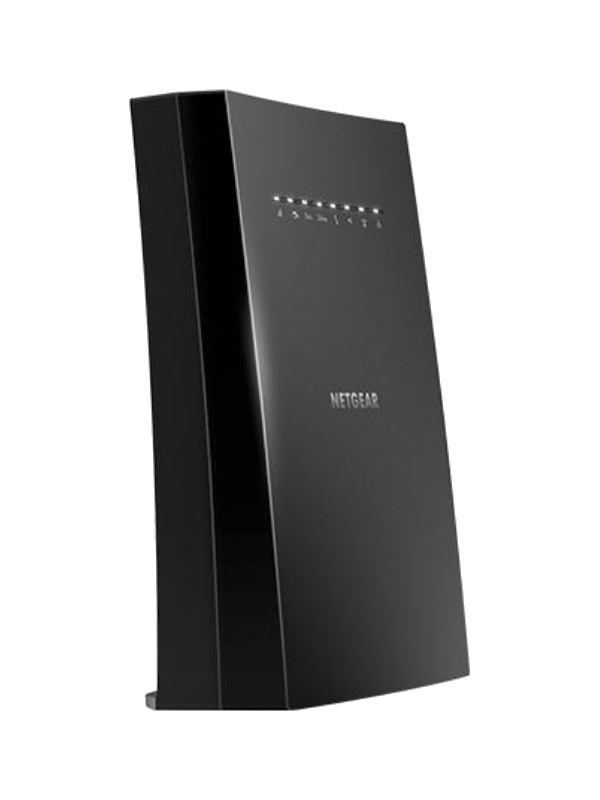
- Coverage: 50 feet
- Max speed (Wi-Fi): 318.21 Mbps
- Separate networks: No
- Recommended for: 1000 Mbps or below (due to tri-band)
- Wireless standard: Wi-Fi 5
- Warranty: 1-year
Pros
- Good range
- Fast speed
- 4 Ethernet ports
Cons
- Some setup delays
The Netgear X6S EX8000 is our top pick if you’re looking for a Wi-Fi extender with Ethernet. It provides a great mix of range, speed, and price.
Connecting the X6S to the router with Ethernet yielded speeds of 628.21 Mbps at 5 feet. Plus, it has four Ethernet ports that you can use to connect printers, gaming consoles, computers, etc., directly to your network. Most Wi-Fi extenders come with just one Ethernet port.
And although this isn’t the fastest extender we tested, it provides enough speed to download around 130 GB in just under a half-hour on Wi-Fi.
On Wi-Fi, the 5 GHz band offered speeds of:
- 318.21 Mbps at 5 feet
- 184.51 Mbps at 15 feet
- 158.51 Mbps from 25 feet
We should note that we used a great router during the testing – the ASUS RT-AX88U router. If you’re using a less powerful or older router, your speed, range, and performance may be different.
The X6S range was good at 50 feet (which is about average). The Wi-Fi range will come in handy for devices that aren’t using Ethernet. If you position this extender detector in a central location, it should be enough to provide Wi-Fi to most multi-story homes.
The Netgear X6S EX8000 AC3000 wasn’t all flowers and sunshine– we had a little difficulty setting it up. But it performs well now. It just took a couple of tries to link it with the router.
The Netgear X6S is a tri-band extender, meaning it has one 2.4 GHz band and two 5 GHz bands. This increases your bandwidth and makes connecting many devices possible (perfect for homes with many smart home sensors and wireless devices).
Setting up the Netgear X6S had some challenges, but it’s a decent extender with good range, excellent speed, and four Ethernet ports.
It also has a single network, which operates better with laptops, smartphones, tablets, etc., since you won’t have to change networks when you go from room to room in your house.
The X6S’s combination of fantastic speed, range, multiple Ethernet ports, and a fair price make it our top pick out of all the Wi-Fi extenders with Ethernet.
#2 TP-Link RE650 AC2600 – Best Range
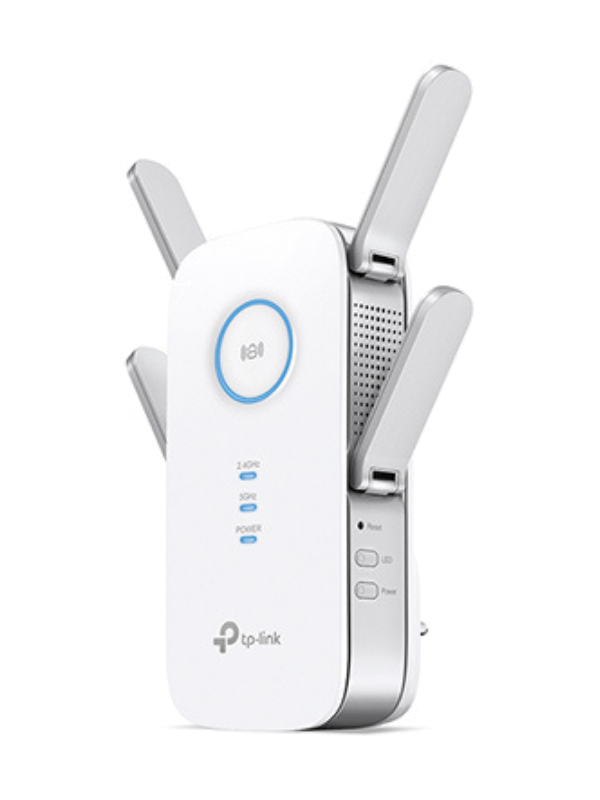
- Coverage: ~70 feet
- Max speed (Wi-Fi): 332.58 Mbps
- Separate networks: Yes (not with TP-Link routers)
- Recommended for: 600 Mbps or below
- Wireless standard: Wi-Fi 5 AC2600
- Warranty: 3 years
Pros
- Fast speed
- 3-year warranty
- Great range
Cons
- Creates a secondary network
- Only one Ethernet port
For a Wi-Fi extender with Ethernet connectivity and the best range, we recommend the TP-Link RE650 AC2600.
The TP-Link RE650 (802.11ac) is the furthest reaching Wi-Fi booster we’ve ever tested, with a Wi-Fi signal reaching 70 feet and 80 feet on Ethernet.
It covers a wide area and can reach all of your rooms, even in large houses. You might even be to extend Wi-Fi to your back patio, too, if you like browsing the Internet outdoors.
Along with its excellent range, the TP-Link RE650 also has a gigabit Ethernet connection built in. So, if you want to hardwire in a nearby gaming console, smart TV, or computer and get the fastest speeds possible, you can.
On the 5 GHz band, the RE650 provides fast Wi-Fi and Ethernet speeds of 332.58 Mbps at five feet and 657.23 Mbps, respectively.
With its fast speed, you could download a new video game while simultaneously streaming a handful of 4k videos, all while you’re working from home (on your back patio) without an issue.
And it works with all major Wi-Fi routers, no matter the brand and model.
A slight downside of the RE650 is that it is dual-band and not tri-band like some other extenders on this list. It is still plenty fast; it just has less bandwidth and can’t connect as many devices as a tri-band unit.
The set-up was a breeze and only took a couple of minutes. The Tether app from TP-Link made it a snap to get the RE650 up and running.
Some users might find the RE650’s two networks challenging to manage with wireless devices when moving from room to room. But, if your primary use is the direct Ethernet connection, this won’t matter much to you.
But, if you have a TP-Link router that supports OneMesh or connect it to your router with Ethernet, you’ll just have one network.
Overall, the TP-Link RE650 AC2600 is an excellent Wi-Fi extender for customers looking for the greatest coverage possible on Wi-Fi with the added bonus of a gigabit Ethernet port. The major disadvantage is that if you don’t have OneMesh, it will set up a secondary network.
#3 Netgear EAX80 AX6000 – Most Ethernet Ports
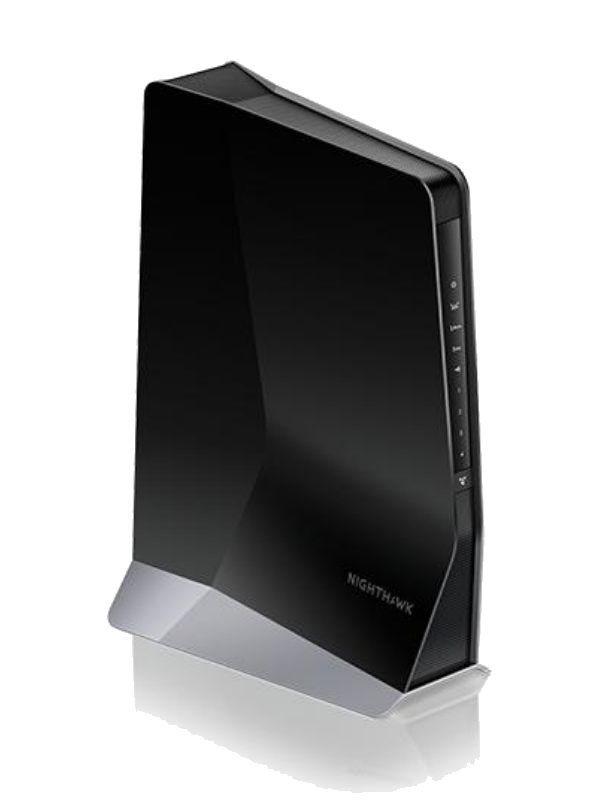
- Coverage: ≈ 65 feet
- Max speed (Wi-Fi): 437.34 Mbps
- Separate networks: No
- Recommended for: Any internet plan
- Wireless standard: Wi-Fi 6 AX6000
- Warranty: 1-year
Pros
- Fantastic range
- Single network
- Fast
- 4 Ethernet ports
Cons
- Some problems setting up
- More expensive than other options
The Netgear EAX80 is our top extender choice with the most Ethernet ports. Really, it’s tied with the Netgear X6S (our #1 pick) with four ports.
This means you can connect up to four network devices directly to Ethernet without being right next to your router.
Plus, it can extend your Wi-Fi signal by 65 feet (when connected to your router wirelessly) and 75 feet when connected to your router via Ethernet. That is enough range to provide strong Wi-Fi to every room in your house.
In our tests, the EAX80 extender delivered speeds of 436.34 Mbps on Wi-Fi and 811.59 Mbps on Ethernet at five feet using the 5 GHz band.
With a speed that fast, you can download nearly 150 GBs in about an hour.
The Netgear EAX80 also supports the new 802.11ax wireless networking standard (Wi-Fi 6), which means you get the fastest speeds, lowest latency, and higher bandwidth.
The EAX80 has a distinct edge over many extenders in that it has a single network. If you use a mobile device, you can explore your home worry-free since there’s no need to worry about the network you’re using.
The EAX80 ranked high in our speed and distance tests, but it wasn’t entirely positive.
It was more complicated and took us much longer to set up than other extenders on this list. We also had to reset the EAX80 when we changed from Wi-Fi to Ethernet because it wouldn’t work.
But, after these problems, it worked well. Along with these configuration downsides, it’s also more expensive than the other four extenders we recommend in this article.
Despite its faults, the Netgear EAX80 AX6000 is a fantastic choice for a Wi-Fi extender if you want plenty of Ethernet ports away from your router and one that can cover the broadest possible area with Wi-Fi and deliver outstanding performance.
#4 Netgear EX7300 AC2200 – Best Value
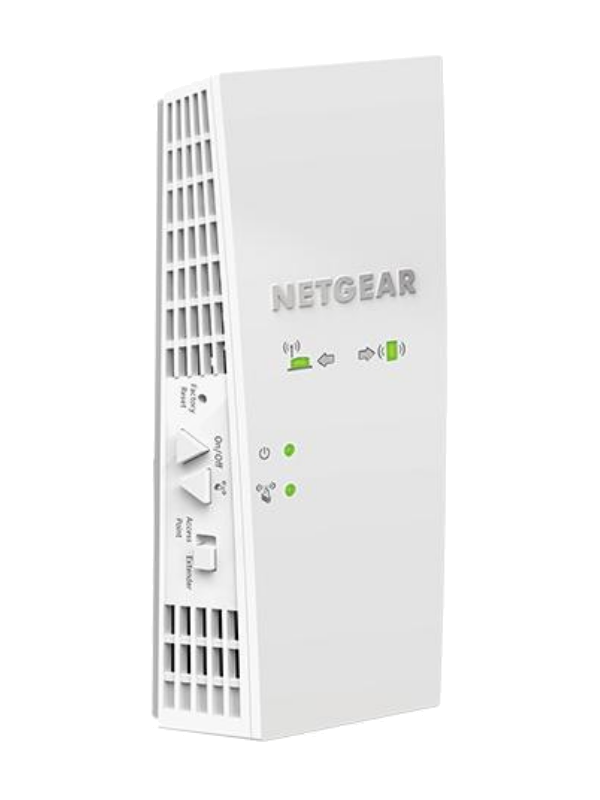
- Coverage: 60 feet
- Max speed (Wi-Fi): 324.58 Mbps
- Separate networks: Yes
- Recommended for: 600 Mbps or lower
- Wireless standard: Wi-Fi 5
- Warranty: 1-year
Pros
- Quick setup
- Low-cost
- Good range
Cons
- Setup hiccups
- Second network
- Only one Ethernet port
If you have a slower internet plan (less than 500 Mbps) and need just one Ethernet port, the Netgear EX7300 is an excellent all-around choice.
During our testing, the 5 GHz band delivered a peak speed of 324.58 Mbps from 5 feet, 239.65 Mbps from 15 feet, and 254.25 Mbps from 25 feet.
And if you’re paying attention, that speed increase wasn’t a typo. Surprisingly it got faster at 25 feet than 15 feet.
For the most part, this speed is adequate for the average family’s internet needs, especially on slower internet plans.
When we connected this extender to the router with Ethernet, its performance improved dramatically, reaching more than double the throughput at 651.58 Mbps.
That is so quick that you can download a full video game like Call of Duty: Infinite Warfare (101 GB) in 22 minutes and 11 seconds.
The Wi-Fi range was good, about an average of the extenders we tested– about 60 feet. If you place this extender in a central location, it should be enough to cover most average-sized homes with a Wi-Fi bubble.
Furthermore, the EX7300 has a single network (the same as your router’s).
This means you won’t have to switch back and forth between networks with wireless devices when moving about the house.
The EX7300’s installation was passable. We had trouble connecting it to the router, but we resolved it after a complete reset of the extender.
In general, the Netgear EX7300 is a decent all-around extender with acceptable performance and range and a single Ethernet port. It also has combined networks, which is convenient.
#5 TP-Link RE315 AC1200 – Budget-Friendly
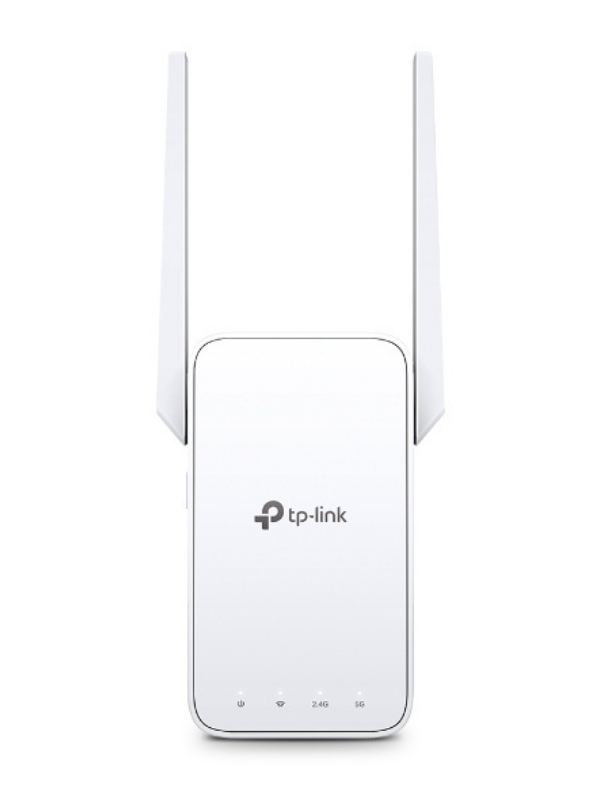
- Coverage: 60 feet
- Max speed (Wi-Fi): 187.61 Mbps
- Separate networks: Yes (unless you use OneMesh)
- Recommended for: 300 Mbps or below
- Wireless standard: Wi-Fi 5
- Warranty: 3 years
Pros
- Easy setup
- Decent range
Cons
- Creates a second network
- Only one Ethernet port
The TP-Link RE315 AC1200 is our budget-friendly choice. It has one Ethernet port and works well with Internet plans of 300 Mbps or less. And it provides decent performance and range for its low price.
The RE315 increased our Wi-Fi signal to 60 feet on Wi-Fi and 70 feet on Ethernet. This is enough to cover the entirety of your house with Wi-Fi.
The TP-Link RE315 performed well on the 5 GHz band, reaching speeds of 187.61 Mbps at 5 feet and 165.21 Mbps at 15 feet when connected via Wi-Fi during our tests.
When we connected the extender directly to our router with an Ethernet cable, the speed climbed to 302.51 Mbps.
This is more than enough speed for those on a 300 Mbps or slower plan.
You can also avoid having two networks if you have a TP-Link router with OneMesh or an Ethernet connection. Otherwise, it creates a brand-new, secondary network.
If you have two networks, you’ll need to alternate between them as you move throughout your house with wireless devices.
The TP-Link RE315 AC1200 also has a simple setup process. It took us just a few minutes using the TP-Link Tether mobile app.
In conclusion, the TP-Link RE315 AC1200 is a fantastic low-cost option for homes with basic internet service that need an extra Ethernet port away from the router and want to save money.
It is an easy-to-use and inexpensive Wi-Fi extender with enough speed and coverage for typical usage. One disadvantage is setting up a second network if you don’t use OneMesh or Ethernet.
Do you need a Wi-Fi Extender?
If your Wi-Fi router effectively delivers service to your home and you just need to improve the signal strength in one room or part of your property, a Wi-Fi extender may be the ideal answer.
But, you may wish to consider relocating your router to a central location first. Depending on where your router is currently located and the layout of your home, this alone may solve your problem.
Let’s say you have a device that can’t connect to a Wi-Fi network, but it has an Ethernet port.
In that case, you should get a Wi-Fi extender with Ethernet to access the network (assuming it is too far from the router to connect directly).
Consider buying your own modem if you are dissatisfied with the performance of the unit from your ISP.
Suppose you upgrade to a premium modem and router; you most likely will not need an extender.
For a modem, check out our article on the best modems. And for a router, check out our article on the best routers.
Ethernet Wi-Fi Extender Buying Guide
This is what you should consider before buying a Wi-Fi extender/repeater with Ethernet. For a more general guide read our repeater buying guide.
Match the Brand
We recommend matching the brand of your extender to your router.
Suppose you can’t connect your Wi-Fi extender to your router with an Ethernet cable. In that case, you will have to connect it via Wi-FI.
If you match the brand of your Wi-Fi extender with your router, you will have better compatibility, a single network (like OneMesh on TP-Link routers), and an easier/faster time setting it up.
We should note that even if you don’t connect your extender to your router with Ethernet, you can still connect a gaming console, computer, smart TV, etc., to the extender with Ethernet.
Wi-Fi 5 vs. Wi-Fi 6
Wi-Fi 5 and Wi-Fi 6 are the two most popular Wi-Fi protocols today.
The distinction is that Wi-Fi 6 is generally faster, capable of handling more devices, and more secure. While Wi-Fi 5 is less expensive on average and has slower speeds.
When purchasing a Wi-Fi extender with Ethernet, we recommend matching your router’s Wi-Fi standard.
You don’t need to buy a Wi-Fi 6 extender if your router is Wi-Fi 5 and vice versa since you wouldn’t be able to use the upgraded features.
Even so, you could invest in a Wi-Fi 6 extender to ensure your home network is future-proofed (especially if you plan to upgrade your router soon).
If you have an internet plan with speeds above 200 Mbps and signed up within the last one to two years, you likely have a Wi-Fi 6 router.
But if you have less than 200 Mbps or got your unit over two years ago, you most likely have Wi-Fi 5.
To determine precisely what you have, check the bottom of your device. If it has 802.11ac on the label, you have Wi-Fi 5 and Wi-Fi 6 if it says 802.11ax.
Check out this article on Wi-Fi 5 vs. Wi-Fi 6 for additional details.
What if my Router is Wi-Fi 4?
If you have a Wi-Fi 4 router, get a new router rather than purchasing an extender.
Simply upgrading to a Wi-Fi 5 or Wi-Fi 6 router could entirely eliminate any dead spots in your home.
Dual-band vs. Tri-band
Dual-band Wi-Fi extenders are more common and less expensive but have less bandwidth. These units work on both the 2.4 GHz and 5 GHz frequencies.
On the other hand, tri-band Wi-Fi extenders work on the 2.4 GHz and 5 GHz frequencies, as well as an extra Wi-Fi channel in between them (useful for Wi-Fi 6).
Tri-band Wi-Fi extenders can be more expensive, but if you have Wi-Fi 6, have lots of network devices, or just want the extra bandwidth, we recommend buying a tri-band model.
However, if your router is dual-band, consider saving money by purchasing a dual-band WiFI extender with Ethernet. With that said, a tri-band extender will work with a dual-band router and vice-versa.
For more info, check out our article on dual-band vs. tri-band here.
Coverage
On the product page and label of each Wi-Fi booster, it will usually show its range.
However, the majority of them are incorrect. Some are too high, and many are too low.
The extenders we tested covered between 70 and 120 percent of their stated range. To ensure that your Wi-Fi reaches your dead zones, we recommend purchasing an extender with a 30 percent greater range than the distance you require.
Even if your main plan is to use an extender for extra Ethernet ports, having adequate Wi-Fi coverage for your home is still important. Why not make sure your home has excellent Wi-Fi coverage too?
It’s also important to keep in mind that the quality of your router determines the range of your extender. A stronger signal can be provided to the extender if you have a better and faster router.
You should also be concerned about how far or close the extender is from the router. Both of these factors result in slower speeds and less coverage.
Connected to the Router Using Ethernet or Wi-Fi
Most Wi-Fi extenders will have the option to either connect to your router using Wi-Fi or Ethernet.
While Wi-Fi is typically sufficient for most devices, you may want to use an extender with Ethernet if you need a faster connection for gaming consoles, smart TVs, PCs, and other network devices.
Still, Wi-Fi is more convenient than Ethernet since it allows you to connect any device without manually plugin or moving cables around.
Overall, Wi-Fi is a great option for most people and will likely provide you with good performance. But if you want the fastest and most stable connection possible, then connecting an extender with Ethernet may be a better choice for you.
So, what mode is best?
Connecting your router to the extender with Ethernet is always better (assuming you can run a cable).
During our testing, we found that connecting an extender to the router with Ethernet provided roughly twice the speed and 20 percent more range than a Wi-Fi connection.
The extender always acts as an access point on Ethernet, which means it never creates a second network.
Ethernet connections are more steady than Wi-Fi. This is beneficial for online meetings, viewing 4k videos, or playing online video games.
As far as we’re concerned, the ideal choice is to use Ethernet whenever feasible.
The only disadvantage of using Ethernet is that you have to be able to run an Ethernet cord from the router. And depending on the layout of your home, that may be impossible or impractical.
Mesh Wi-Fi vs. Wi-Fi Extender/Repeater
Wi-Fi boosters and Mesh Wi-Fi systems are the most common ways to expand home Wi-Fi networks. But which is better, Wi-Fi boosters or Mesh Wi-Fi?
There are several factors to consider when choosing between Wi-Fi boosters and mesh Wi-Fi systems. Some of the most important factors include the size of your home, your Wi-Fi needs, and your budget.
Wi-Fi boosters are typically much cheaper than mesh Wi-Fi systems. And for smaller homes with modest Wi-Fi needs, a Wi-fi booster may be all you need to get a solid connection throughout your house.
Suppose you have a larger home or heavy network usage (gaming console, streaming TV service, smart home devices, etc.).
In that case, it may be worth investing in a mesh Wi-FI system instead since they can handle more traffic and create a large Wi-Fi bubble encompassing your entire home via multiple nodes.
Also, most mesh Wi-Fi nodes have built-in Ethernet ports. So, if you need to hardwire devices in multiple areas of your home, consider a mesh network. But if you just need an Ethernet plug in one area, go with an extender.
Read our article on Mesh Wi-Fi vs. Wi-Fi Repeaters for the full details.
How to Set Up an Extender With Ethernet
Here is the quickest way to set up a Wi-Fi extender.
- First, find a good location for the extender. Place it in an area where you get the strongest Wi-Fi signal from your router.
- Once you have found a good location, plug in the extender and wait for it to power on.
- Next, connect the extender to your router using an Ethernet cable. If your router has Wi-Fi Protected Setup (WPS), you can also connect wirelessly by pressing the WPS button on both devices.
- After the extender is connected to your router, download the extender’s app and open the setting to finish the configurations (it will walk you through it step-by-step).
For a more in-depth guide with troubleshooting, click here.
FAQs
Here are a few of the most common questions we get about Wi-Fi boosters with Ethernet.
Which is the best Wi-Fi Extender with Ethernet?
The best Wi-Fi extender with Ethernet ports is the Netgear X6S EX8000 AC3000. It is fast, affordable, and has four Ethernet ports.
But, this extender may not be the right fit for everybody. For example, the TP-Link RE315 AC1200 may be better for you if you have a slower Internet plan and only need one Ethernet port.
Do I need a Wi-Fi extender with Ethernet ports?
Suppose you want to connect a device, like your computer, smart TV, network drive, or other devices directly to Ethernet and are too far from your router. In that case, yes, you need a Wi-Fi extender with an Ethernet port.
If you need to connect more than one device, consider a Wi-Fi extender with multiple Ethernet ports like the Netgear EAX80 AX6000 and Netgear X6S EX8000 AC3000 (both have four Ethernet ports).
What Ethernet cable should I use with my Wi-Fi extender?
We recommend using at least a CAT 6 Ethernet cable. These cables are higher quality, more dependable, and give you faster Wi-Fi speeds. But a Cat 5e cable will work too and be less expensive but slower.
Look at our guide on Cat 5e and Cat 6 for more details.
The Final Verdict
If you have a Wi-Fi dead spot in your home and need to connect a device to Ethernet, you need a Wi-Fi extender.
The Netgear X6S EX8000 AC3000 is the best choice for anybody needed to bring Ethernet connectivity to a room far away from their router.
It’s fast, affordable, has plenty of Ethernet ports, and provides a fantastic Wi-Fi range. But it had some minor setup delays.
